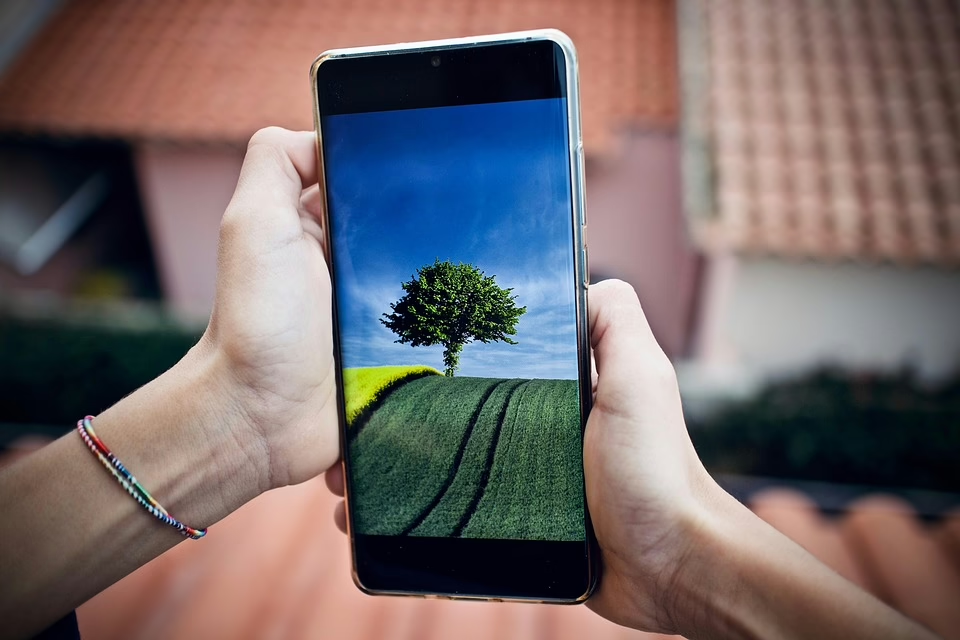iPhone Evolved: Tracing Apple’s Smartphone Legacy
Abstract:
The iPhone. The name itself evokes images of sleek design, intuitive user interfaces, and a transformative impact on the world of mobile technology. But the iPhone didn’t spring fully formed from the minds of Apple engineers. Its journey is a story of evolution, a meticulous process of refinement, innovation, and adaptation that has seen it progress from a revolutionary concept to a ubiquitous global device. This article delves into the rich history of the iPhone, meticulously tracing its evolution from the groundbreaking original to the cutting-edge models of today. We explore key design decisions, technological advancements, and the competitive landscape that shaped the iPhone’s trajectory, examining the impact of each generation on the mobile industry and the cultural zeitgeist. By analyzing the successes, missteps, and enduring features of each iteration, we aim to understand not only the history of the iPhone but also the principles that underpin Apple’s enduring success in the smartphone market.
Keywords: iPhone, Apple, Smartphone, Mobile Technology, Evolution, Innovation, Design, iOS, User Interface, Market Analysis, History, Technology.
1. Introduction: The Genesis of a Revolution
Before 2007, the smartphone market was a fragmented landscape dominated by devices like the BlackBerry and Palm Treo. While capable, these devices often prioritized business functionalities over user experience, featuring complex interfaces and a reliance on physical keyboards. Apple, known for its user-centric design philosophy and history of disrupting established industries, saw an opportunity to redefine the mobile experience.
The initial concept for the iPhone wasn’t simply about shrinking a computer into a pocket-sized device. It was about creating a fundamentally new way to interact with technology on the go. Steve Jobs, in his iconic 2007 keynote, famously presented the iPhone as three products in one: a revolutionary mobile phone, a widescreen iPod with touch controls, and a breakthrough internet communications device.[mfn 1] This ambition set the stage for a device that would not only compete with existing smartphones but also challenge the very definition of what a mobile phone could be.
The development of the iPhone was shrouded in secrecy, a characteristic of Apple’s product development process. The project, codenamed “Purple,” involved a dedicated team working under intense pressure to create a device that met Jobs’ exacting standards. The result was a device that combined a large multi-touch display, a minimalist design, and a custom-built operating system, iOS (originally known as iPhone OS).
2. The First Generation: A Bold Statement (2007)
The original iPhone, released in June 2007, was a gamble that paid off handsomely. Its 3.5-inch touchscreen display, intuitive multi-touch interface, and lack of physical keyboard were radical departures from the prevailing industry norms. While it lacked features now considered essential, such as 3G connectivity and an app store, the original iPhone was revolutionary for its time.
-
Key Features:
- 3.5-inch multi-touch display
- 2-megapixel camera
- Visual Voicemail
- Safari web browser
- iPod functionality
- iPhone OS 1.0
-
Impact: The iPhone’s immediate impact was profound. It redefined the user experience on mobile devices, popularizing the use of touchscreens and intuitive interfaces. Its integrated iPod functionality appealed to a broad audience, while its web browsing capabilities opened up new possibilities for mobile internet access. The lack of a physical keyboard was initially met with skepticism, but the iPhone’s predictive text and autocorrect features quickly won over users.
-
Limitations: Despite its groundbreaking features, the original iPhone had its limitations. The lack of 3G connectivity meant slower internet speeds, and the absence of an app store severely restricted its functionality. The camera was rudimentary by modern standards, and the battery life was a common complaint. Furthermore, the initial high price point made it inaccessible to many consumers.
3. The Rise of 3G and the App Store: Solidifying the Foundation (2008)
The second-generation iPhone, the iPhone 3G, addressed several of the limitations of its predecessor. Its most significant upgrade was the addition of 3G connectivity, enabling faster download and browsing speeds. This was crucial for enhancing the mobile internet experience and making the iPhone a more viable alternative to traditional computers for accessing information and entertainment on the go.
However, the introduction of the App Store in July 2008, alongside the release of iPhone OS 2.0, was arguably the most transformative change. This opened the floodgates for third-party developers to create applications for the iPhone, dramatically expanding its functionality and appeal. The App Store quickly became a thriving ecosystem, offering everything from games and social networking apps to productivity tools and utilities.
-
Key Features:
- 3G connectivity
- App Store
- GPS
- iPhone OS 2.0
-
Impact: The iPhone 3G and the App Store catapulted the iPhone into the mainstream. The availability of a vast library of applications transformed the iPhone from a simple mobile phone into a versatile platform for entertainment, communication, and productivity. This established the iPhone as a leader in the smartphone market, setting the stage for its continued dominance.
-
Refinements: In addition to 3G connectivity and the App Store, the iPhone 3G also included GPS capabilities, further enhancing its functionality. The device’s design was also subtly refined, with a curved plastic back replacing the aluminum casing of the original iPhone.
4. Speed and Performance: The iPhone 3GS (2009)
The iPhone 3GS, released in 2009, focused primarily on improving the performance of the device. The “S” in its name stood for “speed,” reflecting the significant enhancements made to the iPhone’s processing power and overall responsiveness. This was achieved through a faster processor, increased RAM, and optimized software.
-
Key Features:
- Faster processor
- Improved camera (3 megapixels with video recording)
- Voice Control
- Digital Compass
- iPhone OS 3.0
-
Impact: The iPhone 3GS addressed one of the primary criticisms of its predecessors – its sometimes sluggish performance. The improved speed and responsiveness made the user experience significantly smoother and more enjoyable. The addition of video recording capabilities to the camera also made the iPhone a more versatile multimedia device.
-
Voice Control: The iPhone 3GS also introduced Voice Control, allowing users to control certain functions of the phone using voice commands. This was an early step towards the voice-activated assistants that would become ubiquitous in later smartphones.
5. A New Design and the Retina Display: The iPhone 4 (2010)
The iPhone 4, released in 2010, represented a major redesign of the iPhone, both internally and externally. The device featured a sleek new design with a stainless steel band and a glass front and back. However, its most significant feature was its Retina display, which boasted a significantly higher pixel density than previous iPhones, resulting in sharper and more vibrant visuals.
-
Key Features:
- Retina display
- A4 processor
- 5-megapixel camera with LED flash
- 720p video recording
- FaceTime video calling
- Gyroscope
- iOS 4
-
Impact: The iPhone 4’s Retina display set a new standard for display quality on mobile devices. The sharper visuals made everything from text to images look crisper and more detailed, significantly enhancing the user experience. The new design was also widely praised for its elegance and premium feel.
-
FaceTime: The introduction of FaceTime video calling was another significant addition, allowing users to make video calls over Wi-Fi. This helped to popularize video calling on mobile devices and paved the way for other video calling services like Skype and Google Hangouts.
-
“Antennagate” Controversy: Despite its many strengths, the iPhone 4 was also plagued by a significant controversy known as “Antennagate.” Users reported that the phone’s cellular signal could be weakened or dropped when the device was held in a certain way, covering the antenna band. Apple addressed the issue by providing free bumper cases to affected users, but the controversy tarnished the reputation of the iPhone 4 to some extent.
6. Siri and iCloud: Embracing the Cloud (2011)
The iPhone 4S, released in 2011, was an incremental upgrade over the iPhone 4, but it introduced two key features that would become integral to the iPhone experience: Siri and iCloud.
-
Key Features:
- Siri voice assistant
- iCloud integration
- A5 processor
- 8-megapixel camera
- 1080p video recording
- iOS 5
-
Impact: Siri, Apple’s voice-activated assistant, was a game-changer. It allowed users to perform a wide range of tasks using voice commands, from setting reminders and sending messages to searching the web and controlling smart home devices. Siri helped to popularize voice assistants and paved the way for other voice-controlled devices like Amazon’s Alexa and Google Assistant.
-
iCloud: iCloud provided users with a seamless way to sync their data across multiple Apple devices, including iPhones, iPads, and Macs. This made it easier for users to access their photos, contacts, and documents from anywhere, further enhancing the Apple ecosystem.
-
Passing of Steve Jobs: The iPhone 4S was also released shortly after the death of Steve Jobs, the visionary leader who had spearheaded the development of the iPhone. The device served as a tribute to his legacy and a reminder of his profound impact on the technology industry.
7. A Taller Screen and LTE: The iPhone 5 (2012)
The iPhone 5, released in 2012, marked a significant departure from the design of the iPhone 4 and 4S. The device featured a taller 4-inch display with a 16:9 aspect ratio, making it better suited for watching videos and browsing the web. It also included LTE connectivity, providing even faster download and browsing speeds.
-
Key Features:
- 4-inch Retina display (16:9 aspect ratio)
- LTE connectivity
- A6 processor
- 8-megapixel camera with improved low-light performance
- Lightning connector
- iOS 6
-
Impact: The iPhone 5’s taller screen addressed a common criticism of previous iPhones – their relatively small display size compared to competing Android devices. The LTE connectivity provided a significant boost to mobile internet speeds, making the iPhone a more viable option for users who relied heavily on mobile data.
-
Lightning Connector: The introduction of the Lightning connector, a smaller and more versatile connector than the previous 30-pin connector, was another notable change. While it was initially met with some resistance from users who had invested in accessories that used the 30-pin connector, the Lightning connector eventually became the standard for Apple devices.
8. Experimentation with Color and Materials: The iPhone 5s and 5c (2013)
In 2013, Apple released two new iPhone models: the iPhone 5s and the iPhone 5c. The iPhone 5s was a premium device that featured a fingerprint sensor (Touch ID) and a faster A7 processor. The iPhone 5c, on the other hand, was a more affordable option that came in a variety of bright colors and featured a plastic casing.
-
iPhone 5s Key Features:
- Touch ID fingerprint sensor
- A7 processor (64-bit architecture)
- M7 motion coprocessor
- Improved camera (1.5µm pixel size)
- iOS 7
-
iPhone 5c Key Features:
- Polycarbonate casing in multiple colors
- A6 processor
- 8-megapixel camera
- iOS 7
-
Impact: The iPhone 5s’s Touch ID fingerprint sensor was a major innovation, providing a convenient and secure way to unlock the phone and authenticate purchases. The A7 processor was also a significant upgrade, making the iPhone 5s one of the fastest smartphones on the market.
-
iPhone 5c’s Reception: The iPhone 5c was less successful than the iPhone 5s. While its colorful design appealed to some users, its plastic casing and relatively high price point (compared to other mid-range smartphones) limited its popularity.
9. Bigger Screens and Optical Image Stabilization: The iPhone 6 and 6 Plus (2014)
In 2014, Apple finally succumbed to the trend of larger smartphone screens with the release of the iPhone 6 and 6 Plus. The iPhone 6 featured a 4.7-inch display, while the iPhone 6 Plus boasted a massive 5.5-inch display. Both devices featured a redesigned chassis with rounded edges and a thinner profile.
-
Key Features:
- 4.7-inch (iPhone 6) and 5.5-inch (iPhone 6 Plus) Retina HD displays
- A8 processor
- Improved camera with optical image stabilization (iPhone 6 Plus only)
- Apple Pay
- iOS 8
-
Impact: The iPhone 6 and 6 Plus were a huge success, addressing the demand for larger smartphones and attracting users who had previously been drawn to Android devices with bigger screens. The iPhone 6 Plus’s optical image stabilization significantly improved the quality of photos and videos, particularly in low-light conditions.
-
Bendgate Controversy: Similar to the “Antennagate” controversy surrounding the iPhone 4, the iPhone 6 and 6 Plus were also subject to a controversy known as “Bendgate.” Some users reported that the devices could bend or warp under pressure, particularly in the area around the volume buttons. Apple addressed the issue by strengthening the chassis of subsequent models.
10. 3D Touch and Live Photos: The iPhone 6s and 6s Plus (2015)
The iPhone 6s and 6s Plus, released in 2015, were incremental upgrades over the iPhone 6 and 6 Plus, but they introduced two notable new features: 3D Touch and Live Photos.
-
Key Features:
- 3D Touch pressure-sensitive display
- Live Photos
- A9 processor
- 12-megapixel camera with 4K video recording
- Improved Touch ID sensor
- iOS 9
-
Impact: 3D Touch allowed users to access shortcuts and previews by pressing harder on the screen, adding a new dimension to the user interface. Live Photos captured a few seconds of video before and after a still photo, creating a more immersive and dynamic photographic experience.
-
Mixed Reception to 3D Touch: While 3D Touch was innovative, it never fully caught on with users. Many found it difficult to remember which apps and features supported 3D Touch, and it wasn’t always intuitive to use. Apple eventually phased out 3D Touch in later iPhone models.
11. A Return to Form and the Dual-Camera System: The iPhone 7 and 7 Plus (2016)
The iPhone 7 and 7 Plus, released in 2016, brought several significant changes, including a redesigned home button, water resistance, and a dual-camera system on the iPhone 7 Plus.
-
Key Features:
- A10 Fusion processor
- Water and dust resistance (IP67 rating)
- Redesigned Home button (solid-state with Taptic Engine)
- Dual-camera system (iPhone 7 Plus only)
- No headphone jack
- iOS 10
-
Impact: The iPhone 7 and 7 Plus were well-received, particularly the iPhone 7 Plus with its dual-camera system. The dual cameras allowed for optical zoom and a new “Portrait Mode” that created a shallow depth-of-field effect, making photos look more professional.
-
Controversial Removal of Headphone Jack: The removal of the headphone jack was a controversial decision, but it allowed Apple to make the iPhone 7 and 7 Plus thinner and more water-resistant. It also paved the way for the widespread adoption of wireless headphones.
12. A Bold New Design and Face ID: The iPhone X (2017)
The iPhone X, released in 2017, marked the 10th anniversary of the iPhone and represented a radical departure from previous iPhone designs. The device featured an edge-to-edge OLED display with a notch at the top for the front-facing camera and sensors. It also replaced the Touch ID fingerprint sensor with Face ID, a facial recognition system.
-
Key Features:
- Edge-to-edge OLED display with notch
- Face ID facial recognition
- A11 Bionic processor
- Dual 12-megapixel cameras with improved low-light performance
- Wireless charging
- iOS 11
-
Impact: The iPhone X was a technological showcase, pushing the boundaries of smartphone design and functionality. The edge-to-edge display provided a more immersive viewing experience, while Face ID offered a secure and convenient way to unlock the phone and authenticate purchases.
-
Mixed Reactions to the Notch: The notch was a controversial design element, with some users finding it distracting while others quickly adapted to it. However, it allowed Apple to maximize the screen size while still incorporating the necessary sensors for Face ID.
13. Expanding the Lineup: The iPhone XS, XS Max, and XR (2018)
In 2018, Apple released three new iPhone models: the iPhone XS, XS Max, and XR. The iPhone XS and XS Max were premium devices that featured improved cameras, faster processors, and OLED displays. The iPhone XR was a more affordable option that featured a Liquid Retina LCD display and a single rear camera.
-
Key Features:
- A12 Bionic processor
- Improved cameras (XS and XS Max)
- OLED displays (XS and XS Max)
- Liquid Retina LCD display (XR)
- Multiple color options (XR)
- iOS 12
-
Impact: The iPhone XS and XS Max continued to push the boundaries of smartphone performance and camera technology. The iPhone XR was a popular choice for users who wanted a larger screen and modern features at a more affordable price.
-
Introducing a Wide Range of Options: This generation marked Apple’s commitment to offering a wider range of options to cater to different budgets and preferences.
14. Refining the Camera and Introducing Night Mode: The iPhone 11, 11 Pro, and 11 Pro Max (2019)
The iPhone 11, 11 Pro, and 11 Pro Max, released in 2019, focused on improving the camera system and introducing new features like Night Mode. The iPhone 11 featured a dual-camera system, while the iPhone 11 Pro and 11 Pro Max featured a triple-camera system.
-
Key Features:
- A13 Bionic processor
- Dual-camera system (iPhone 11)
- Triple-camera system (iPhone 11 Pro and 11 Pro Max)
- Night Mode
- Improved battery life
- iOS 13
-
Impact: The iPhone 11, 11 Pro, and 11 Pro Max were praised for their improved camera performance, particularly in low-light conditions. Night Mode allowed users to capture stunning photos in dark environments without the need for a flash.
-
Camera Becomes a Primary Focus: This generation cemented the importance of the camera system as a key differentiator in the smartphone market.
15. 5G Connectivity and a Classic Design: The iPhone 12 Series (2020)
The iPhone 12 series, released in 2020, brought 5G connectivity to the iPhone lineup and introduced a redesigned chassis with flat edges, reminiscent of the iPhone 4 and 5. The lineup consisted of the iPhone 12 mini, iPhone 12, iPhone 12 Pro, and iPhone 12 Pro Max.
-
Key Features:
- 5G connectivity
- A14 Bionic processor
- Redesigned chassis with flat edges
- OLED displays (all models)
- Ceramic Shield front cover
- MagSafe wireless charging
- iOS 14
-
Impact: The iPhone 12 series was a significant upgrade, offering faster performance, improved camera quality, and 5G connectivity. The redesigned chassis was also well-received, providing a more modern and premium feel.
-
Introducing a Smaller Flagship: The iPhone 12 mini offered flagship-level performance in a compact form factor, catering to users who preferred smaller phones.
16. Photographic Prowess Enhanced: The iPhone 13 Series (2021)
The iPhone 13 series, launched in 2021, focused on further refining the camera system and improving battery life. The lineup included the iPhone 13 mini, iPhone 13, iPhone 13 Pro, and iPhone 13 Pro Max.
-
Key Features:
- A15 Bionic chip
- Larger camera sensors
- Sensor-shift optical image stabilization (all models)
- Photographic Styles
- Cinematic mode for video recording
- Smaller notch
- iOS 15
-
Impact: The iPhone 13 series further solidified Apple’s position as a leader in mobile photography. The larger camera sensors and sensor-shift optical image stabilization resulted in significantly improved image quality, especially in low-light conditions. Cinematic mode added a new level of creativity to video recording, allowing users to easily create professional-looking videos.
-
Notch Reduction: The smaller notch provided a slightly more immersive viewing experience, albeit a minor improvement.
17. Dynamic Island and Advanced Camera System: The iPhone 14 Series (2022)
The iPhone 14 lineup saw the removal of the mini model and introduced the Dynamic Island on the Pro models, along with enhancements to the camera system. The lineup included the iPhone 14, iPhone 14 Plus, iPhone 14 Pro, and iPhone 14 Pro Max.
-
Key Features:
- A15 Bionic chip (iPhone 14 & 14 Plus), A16 Bionic Chip (iPhone 14 Pro & 14 Pro Max)
- Dynamic Island (iPhone 14 Pro & 14 Pro Max)
- 48MP Main camera (iPhone 14 Pro & 14 Pro Max)
- Emergency SOS via satellite
- Action mode for video recording
- iOS 16
-
Impact: The Dynamic Island was a clever and innovative way to utilize the space around the front-facing camera and sensors, providing users with contextual information and interactive controls. The 48MP main camera on the Pro models allowed for more detailed photos and improved low-light performance.
-
Dynamic Island as a Differentiator: The Dynamic Island became a key feature that distinguished the Pro models from the standard iPhone 14 and 14 Plus.
18. USB-C and Titanium Design: The iPhone 15 Series (2023)
The iPhone 15 lineup addressed long-standing criticisms and incorporated new features. The lineup included the iPhone 15, iPhone 15 Plus, iPhone 15 Pro, and iPhone 15 Pro Max.
-
Key Features:
- A16 Bionic chip (iPhone 15 & 15 Plus), A17 Pro Chip (iPhone 15 Pro & 15 Pro Max)
- USB-C port (all models)
- Titanium design (iPhone 15 Pro & 15 Pro Max)
- Action button (iPhone 15 Pro & 15 Pro Max)
- Improved camera system with 5x optical zoom (iPhone 15 Pro Max)
- iOS 17
-
Impact: The inclusion of USB-C across the entire lineup addressed years of calls for standardization and simplified connectivity. The titanium design on the Pro models offered a lighter and more durable build. The improved camera system on the Pro Max pushed the boundaries of mobile photography and videography further.
-
Titanium and USB-C as Key Updates: This generation focused on addressing practical concerns and enhancing the premium experience with a new material.
19. Conclusion: A Legacy of Innovation and Influence
The iPhone’s journey from a revolutionary concept to a global phenomenon is a testament to Apple’s commitment to innovation, user-centric design, and seamless integration of hardware and software. Each generation of the iPhone has brought new features, improved performance, and refined designs, shaping the mobile industry and influencing the way we communicate, work, and entertain ourselves.
From the groundbreaking original to the technologically advanced models of today, the iPhone has consistently set new standards for smartphone design and functionality. Its impact extends beyond the realm of technology, influencing fashion, culture, and even the way we interact with the world around us.
While the future of the smartphone market is uncertain, the iPhone’s legacy as a transformative device is undeniable. As Apple continues to innovate and refine its flagship product, the iPhone is likely to remain a dominant force in the mobile industry for years to come. The lessons learned from its evolution – the importance of user experience, the power of integrated ecosystems, and the need for constant innovation – will continue to shape the future of mobile technology and beyond. The story of the iPhone is not just the story of a smartphone; it’s the story of how a single device changed the world.
References


























Add Comment